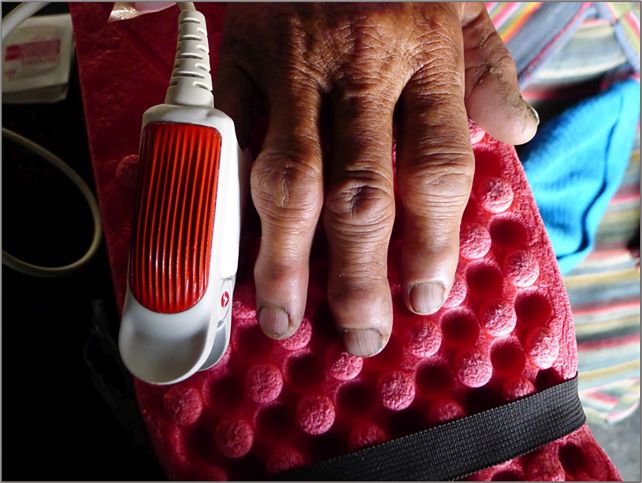People should not but carried out cooking. We’re persevering with to evolve and alter to the world round us, the information of our variations written in our our bodies.
We all know that there are some environments that may make us unwell. Mountain climbers usually succumb to altitude illness – the physique’s response to a big drop in atmospheric stress which implies much less oxygen is taken in with every breath.
And but, in excessive altitudes on the Tibetan Plateau, the place oxygen ranges within the air individuals breathe are notably decrease than decrease altitudes, human communities thrive.
Within the greater than 10,000 years the area has been settled, the our bodies of these dwelling there have modified in ways in which enable the inhabitants to profit from an environment that for many people would end in not sufficient oxygen being delivered through blood cells to the physique’s tissues, a situation generally known as hypoxia.
“Adaptation to high-altitude hypoxia is fascinating as a result of the stress is extreme, skilled equally by everybody at a given altitude, and quantifiable,” anthropologist Cynthia Beall of Case Western Reserve College within the US informed ScienceAlert.
“It’s a lovely instance of how and why our species has a lot organic variation.”
Beall has been finding out the human response to hypoxic dwelling situations for years. In new analysis, she and her workforce have unveiled among the particular variations in Tibetan communities: traits that assist the blood ship oxygen.
To unlock this discovery, the researchers delved into one of many markers of what we name evolutionary health: reproductive success. Girls who ship stay infants are those that move on their traits to the following technology.
The traits that maximize a person’s success in a given setting are almost certainly to be present in ladies who’re capable of survive the stresses of being pregnant and childbirth.
These ladies usually tend to give beginning to extra infants; and people infants, having inherited survivability traits from their moms, are additionally extra prone to survive to maturity, and move the traits on to the following technology.
That is pure choice at work, and it may be a bit unusual and counterintuitive; in locations the place malaria is widespread, for instance, the incidence of sickle cell anemia is excessive, as a result of it entails a gene that protects towards malaria.
Beall and her workforce made a research of 417 ladies between the ages of 46 and 86 years who’ve lived all their lives in Nepal above altitudes of round 3,500 meters (11,480 ft). The researchers recorded the variety of stay births, ranging between 0 and 14 per lady for a median of 5.2, in addition to well being and bodily data and measurements.
Among the many issues they measured have been ranges of hemoglobin, the protein in crimson blood cells accountable for delivering oxygen to tissues. Additionally they measured how a lot oxygen was being carried by the hemoglobin. Apparently, the ladies who demonstrated the best fee of stay births had hemoglobin ranges that have been neither excessive nor low, however common for the testing group.
However the oxygen saturation of the hemoglobin was excessive. Collectively, the outcomes counsel that the variations are capable of maximize oxygen supply to cells and tissues with out thickening the blood – a outcome that will place extra stress on the center because it struggles to pump the next viscosity fluid extra immune to stream.

“Beforehand we knew that decrease hemoglobin was useful, now we perceive that an intermediate worth has the best profit. We knew that increased oxygen saturation of hemoglobin was useful, now we perceive that the upper the saturation the extra useful. The variety of stay births quantifies the advantages,” Beall stated.
“It was surprising to search out that ladies can have many stay births with low values of some oxygen transport traits if they’ve favorable values of different oxygen transport traits.”
The ladies with the best reproductive success fee additionally had a excessive fee of blood stream into the lungs, and their hearts had wider than common left ventricles, the chamber of the center accountable for pumping oxygenated blood into the physique. Taken all collectively, these traits improve the speed of oxygen transport and supply, enabling the human physique to profit from the low oxygen within the air respired.
It is essential to notice that cultural elements can play a task, too. Girls who begin reproducing younger and have lengthy marriages appear to have an extended publicity to the opportunity of being pregnant, which additionally will increase the variety of stay births, the researchers discovered.
Even taking that into consideration, nonetheless, the bodily traits performed a task. Nepalese ladies with physiologies most just like ladies in unstressed, low altitude environments tended to have the best fee of reproductive success.
“This can be a case of ongoing pure choice,” Beall says. “Understanding how populations like these adapt provides us a greater grasp of the processes of human evolution.”
The analysis has been printed within the Proceedings of the Nationwide Academy of Sciences.





